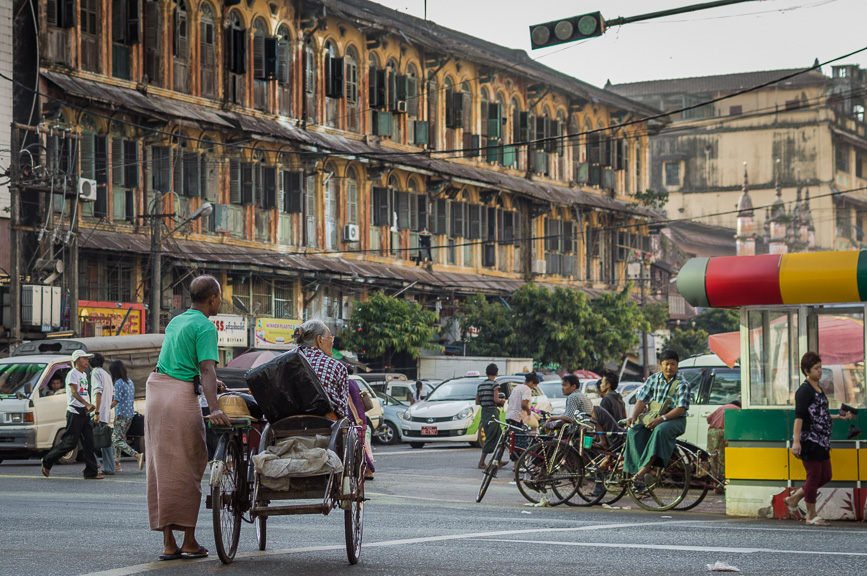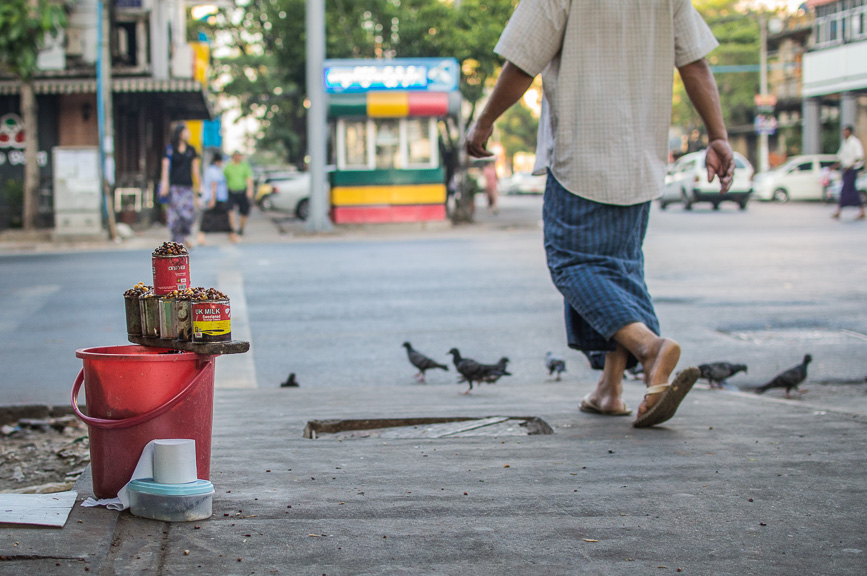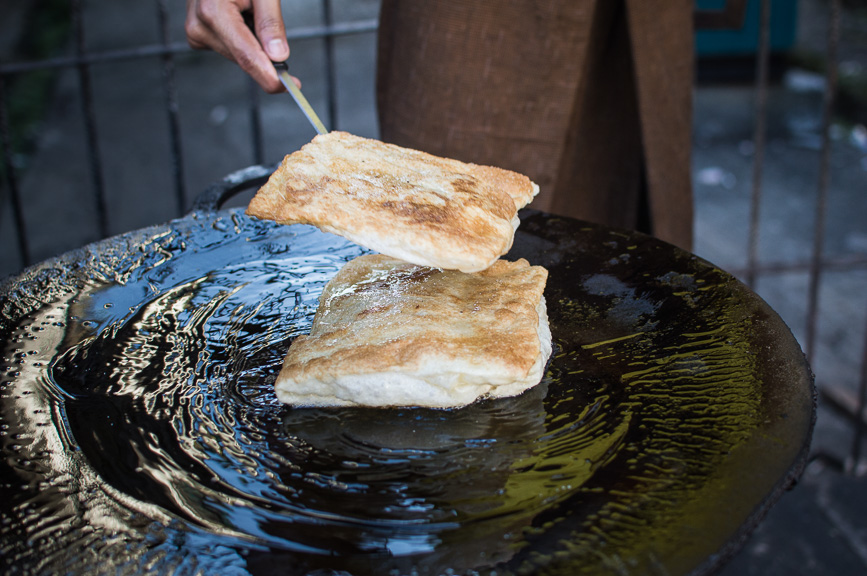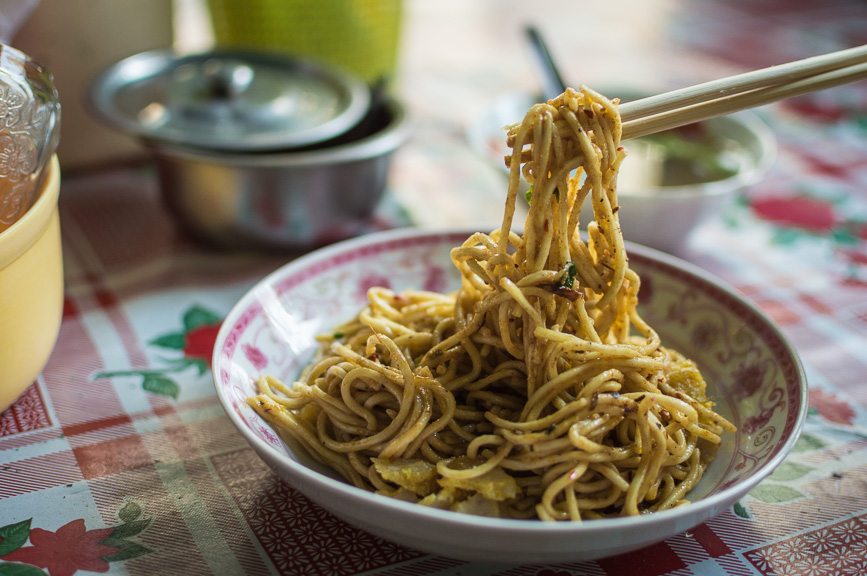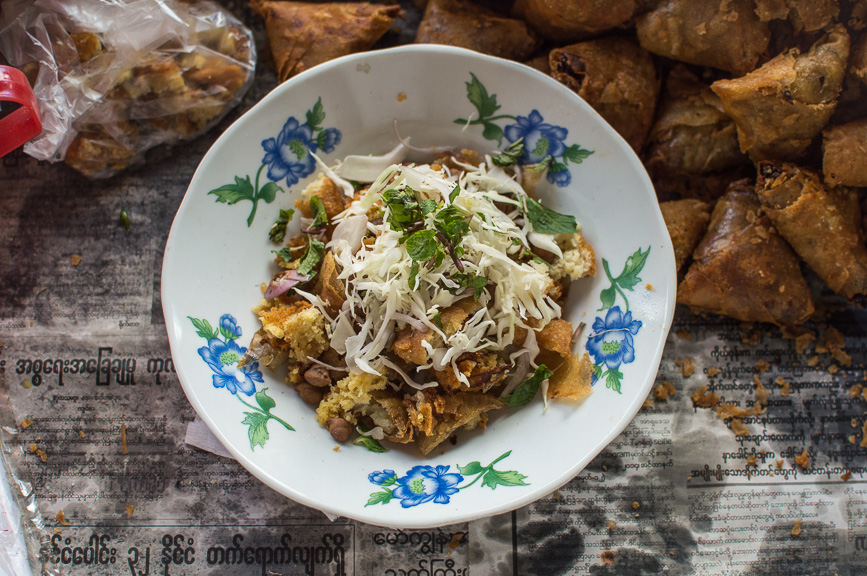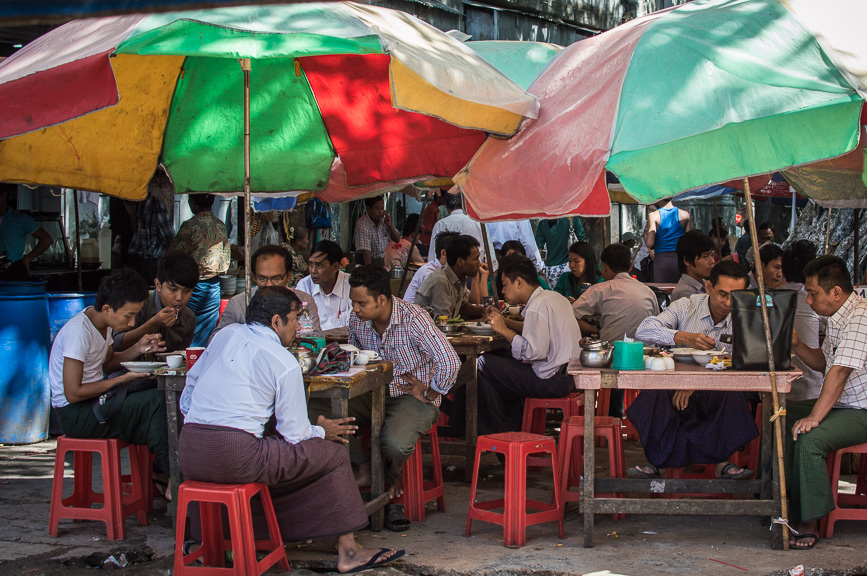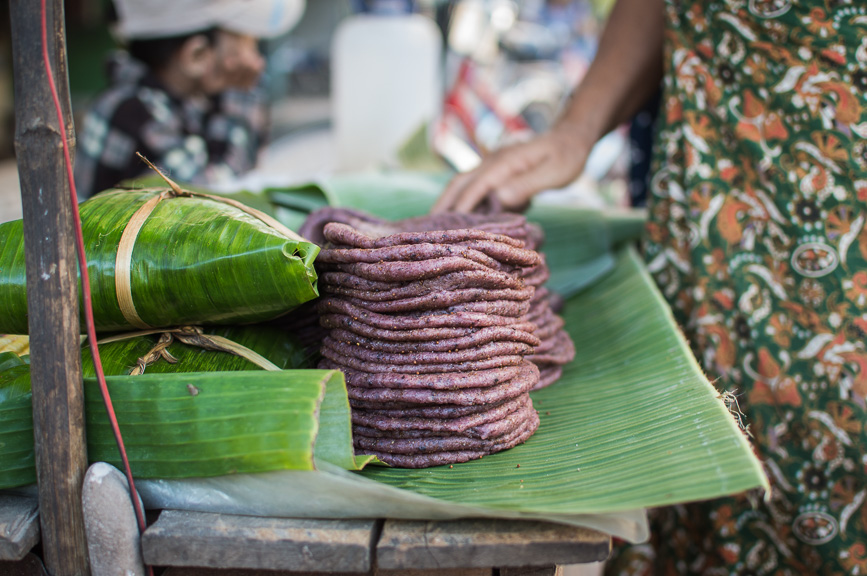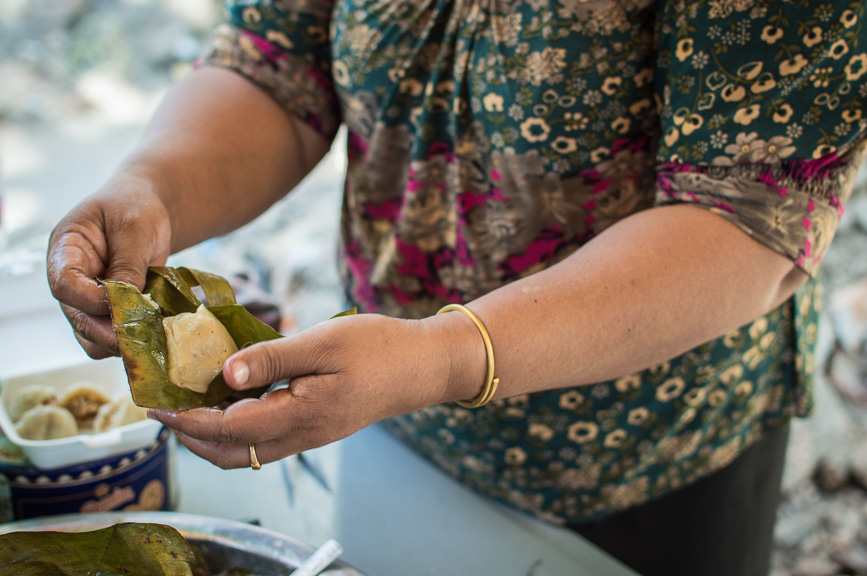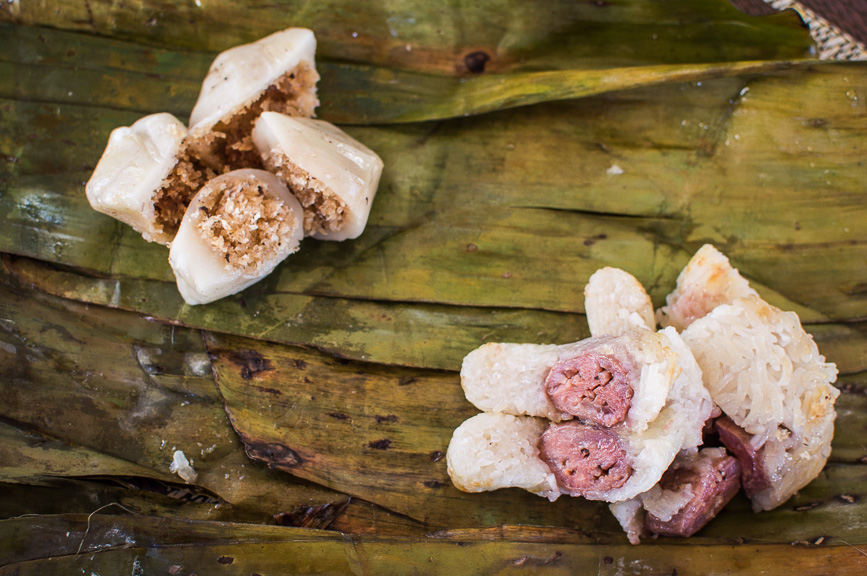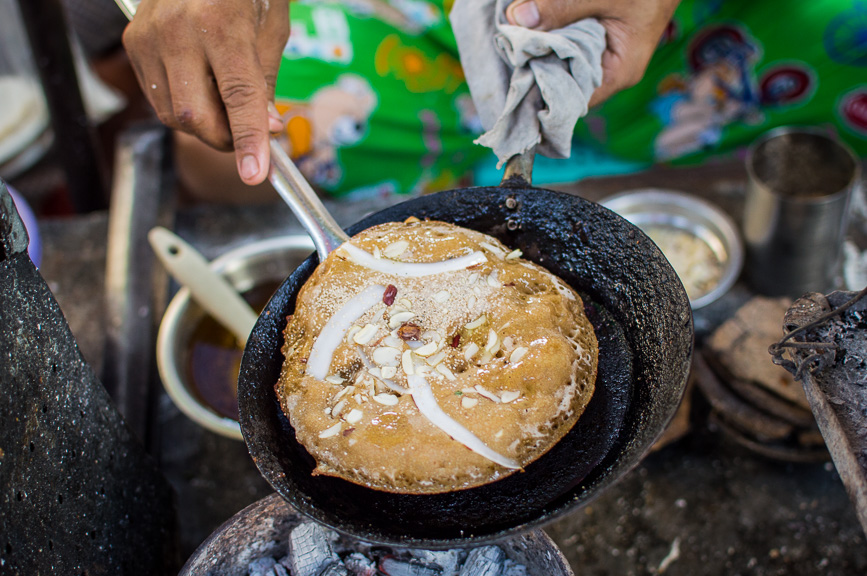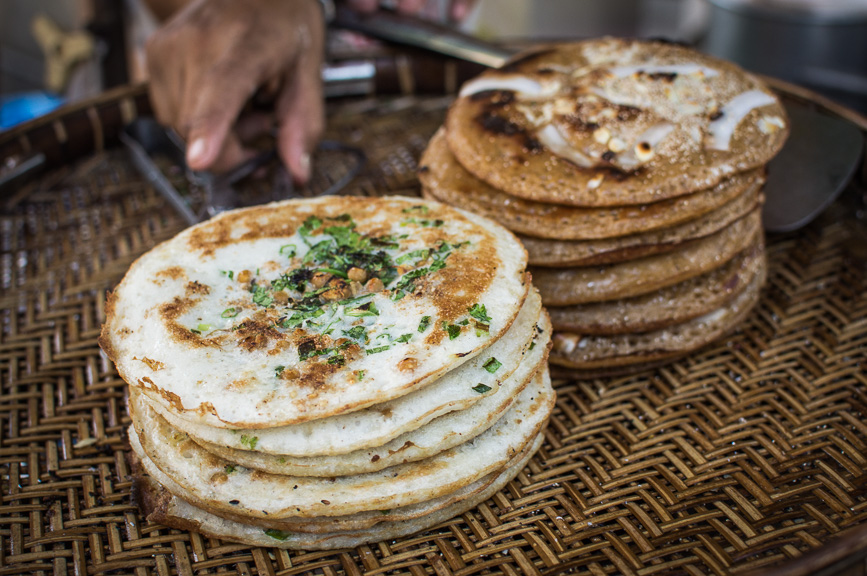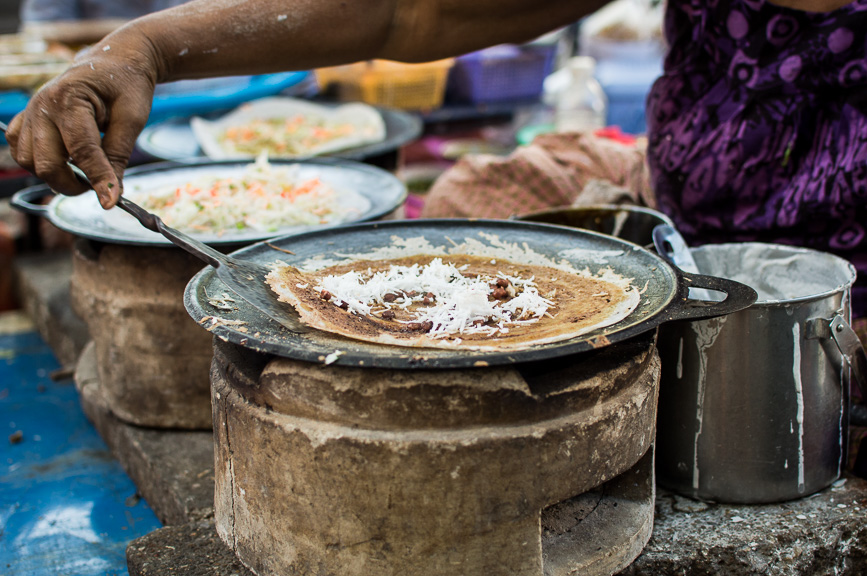YANGON STREET FOOD VENDORS are the kings and queens of the pop-up. Their business takes them wherever they may go, the necessary equipment, set up in a matter of minutes. Unlike street food vendors in some other cities they are mobile every few hours. The face and smell of a street changes every time we walk down it, a different hour, a different menu.
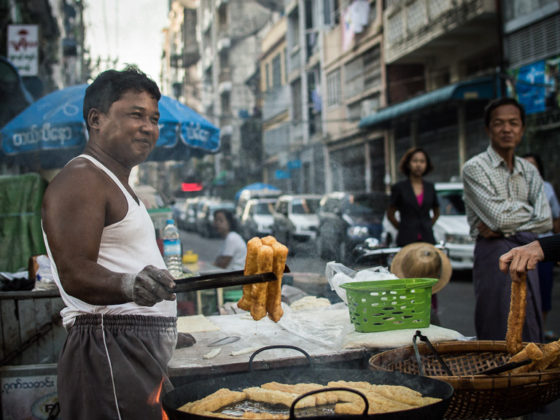

A day in the life of Yangon’s street food will leave you licking your fingers, eyes open for the next thing to devour and with a very sweaty back.
1. E Kya Kway
A breakfast favourite, these deep-fried breadsticks are a version of the chinese youtiao. Much like a lighter savoury donut, it is often dipped in tea or coffee and can be served with congee (rice porridge) or Myanmar’s favourite fish and noodle soup – mohinga. The story behind its paired vertical shape is inspired by a voodoo doll-like concept. During the Song Dynasty, a couple plotted to destroy a great general. As a symbolic protest against the couple, the youtiao was made into two human-shaped pieces of dough, to be deep-fried and eaten in revenge. This evolved into two rolls of dough joined at the middle, the couple hand in hand, one the husband, one the wife.
2. Roti/Paratha
Myanmar lies between India and China, the historical influences of both powers are evident in the faces of its people, their customs and above all savoured in its cuisine. From the Indian side of the spectrum comes the roti. Various shapes of ghee-enriched dough are being stretched out, pounded and laid out. The round ones for the savoury mung bean paste topping, the rolls for cracking an egg in, and the twirled ones to be drizzled with sweet condensed milk. It is hot and oily and crispy and oh so good.
10H00 By ten, the sky’s blue is intense and the black electric cables are empty. The lady in pink with the feed tins and the pigeons have moved on, the big wok of deep-fat frying E kya kway has been replaced with a stand of counterfeit DVDs. The stalls with larger tables and plastic chairs are organising, some already serving hungry customers an early lunch or a quick snack.
3. Khao Sueh Thoke
When in Chinatown, eat noodles. This Burmese dish is one of the popular examples of the country’s love affair with noodles and salads. “Thoke” means salad and the definition is definitely not limited to a bowl of lettuce and tomatoes. The best of Burmese cuisine is often found in its thokes and this combination is a great introduction. Wheat noodles tossed with dried shrimps, shredded cabbage and carrots before being dressed with fried peanut oil, chillies, fish sauce, coriander and lime will leave you wanting more. A pickled mustard greens’ broth, sour and fermented, often comes on the side to balance the flavours, but don’t feel obligated to finish this one.
12H00 The sun is now blazing, yet the flowers in the women’s hair are impeccable, pre-wilt. We move towards the east, where the streets turn into avenues and the ladies are out on their errands, their elegant longyis (traditional Myanmar dress) pressed and spotless. Their buns hold strands of flowers, yellow, purple, orange. A Burmese mother once said to her daughter that, “without flowers, you are not fully dressed.” In these streets, it still holds true.
4. Samosa Thoke
Time for our next thoke. This time cut-up potato and chick pea samosas are the star. To call it a salad is misleading as this is as complex a dish as any other. It is possibly my favourite savoury dish from Myanmar. It is even vegetarian. The crisp pastry of the samosa triangles provides the crunch. Their filling and the extra chickpea falafels provide the protein and creamy weight. Then comes the freshness. From the shredded cabbage, finely chopped raw onions, mint and coriander. Some chillies for spice. A squeeze of lime. The final touch is heat and comfort in the form of a thick masala lentil soup. There are multiple variations to this version, but the secret to this one was a touch of cinnamon.
13H30 We move further east towards the Strand where the majestic colonial buildings are still rather glorious and house current national ministries. Large ceiling fans swirl above grand stairwells, civil servants exit through over-sized wooden doors, their shirts tucked into their longyis as they head to lunch. The pop-up restaurants here are tidier, giving an appearance of better hygiene and cleaner dishes. Their clientele more demanding. The menu is extensive, noodles, soups, rice, curries, but we are more interested in the women sitting by the road. Their perch barely taller than a foot, they pop out of nowhere below eye-level behind the crowd; metal bowls their only recipient and banana leaves their packaging.
5. Koh Pièh
Koh Pièh is a savoury glutinous rice cake which carries a touch of natural sweetness from the coconut added to the mixture. The cake is then coated in toasted sesame seeds and served with extra grated fresh coconut and salt and pepper. It sounds like a peculiar mix, but give me anything with a hint of glutinous rice and coconut and I’m yours.
6. Koh Può
These are also glutinous rice cakes, but grilled over charcoal. The fire ends up giving them a smokey flavour with a thin crust and a chewy centre. They can be made from black glutinous rice or white (I prefer the black) and are topped with a generous dollop of dark jaggery. Jaggery in Myanmar is usually made from toddy palm syrup. The syrup is boiled until it turns a caramel hue and when solid ends up like chunks of thick sticky sugar. It has a deeper flavour than white sugar and is even nicknamed Burmese chocolate.
15H00 The lunch crowd has gone back to work and it is tea time. Outside the government buildings are professional typists, a table, a chair and a typewriter form their street office. Clients patiently wait for their official documents and letters to be typed up before presenting them to the folks upstairs. Personal letters can be composed by those offering handwritten services, their street office composed of a stool and an overturned cardboard box. People resume their shuffling between ministries and the dessert cart lady appears. It is time to satisfy your sweet tooth.
7. Mont Lone Yay Paw
Myanmar is not short on desserts and the Mont Lone Yay Paw is a close relative of many other asian desserts. It is similar to the Chinese tangyuan; or the Japanese mochi. Basically a glutinous rice flour ball with sweet filling. Here they were wrapped in banana leaf and stuffed with jaggery and grated coconut. A traditional dessert to be enjoyed during Thingyan, the weeklong Buddhist Festival during Burmese New Year, the name Mont lone yay paw was inspired by its cooking method of boiling, as it literally means “round snack on the water”.
8. Gahn Niehn Tok / Kauknyintok
If you like bananas, you will like Kauknyintok. I don’t even like bananas and I still love Kauknyintok. Not overly sweet, this surprisingly delicate dessert involves steaming a banana leaf stuffed with banana pieces, glutinous rice, coconut cream, sugar and salt. The flavours remain subtle and the banana melts in your mouth.
9. Bein Mont
Ah. The crème de la crème of Burmese street snacks. At least in our opinion. No matter what you have done during the day, any day in Yangon deserves a Bein Mont. This pancake achieves chewiness, fluffiness, crispiness, nuttiness, lightness and depth at the same time. The sweet version is a glutinous rice flour pancake topped with white poppy seeds, slivered almonds and fresh coconut slices. None of the pancakes I have tried or tested during the pancake frenzy we have seen the past few years have anything on this one. This reigns when it comes to the humble cake in a pan.
17H30 We are in the throngs of rush hour as people make their way home, the pavements are crowded, flip flops, moccasins and a few heels pound away in one direction. New restaurants are now popping up, the dinner ones. Bamboo sticks lift up new tarpaulin covers, woks appear over portable stoves and plastic chairs are unstacked onto the pavement before claiming a quarter width of the main road as well. Back on our corner of 11th and Anawratha, the DVD shop has been replaced by a woman in purple. Three stone stoves are burning before her, cross-legged and surrounded by ingredients, she is flipping dosas.
10. Dosa
By now it is time to switch back to savoury and the dosa is another Indian trick up Myanmar’s sleeve. Originating in Southern India, the dosa is a thin crispy crepe made from a batter of rice and lentils that is allowed to ferment overnight. The fermentation process increases the nutritional benefit and the base is naturally gluten free. Our purple dosa lady ladled her batter onto a flaming iron skillet and topped the thin layer with carrots, onions, cabbage, bean sprouts, chillies, coriander and plenty of black pepper. The perfect pre-dinner snack.
19H00 Yangon is now dark. The teahouses lining the street pavements are full, young and old alike chatting away. Next door the wok of the pop-up restaurant is flaming, churning out fried rice and noodles for its own tables, a well as the ones of the two teashops down the road. Down the side streets are vendors specialising in hot pot, the raw food buffet waiting to be chosen and placed into red plastic baskets before being plunged into boiling broth. The streets are emptying, its rickshaws long gone. I spot a few pigeons roaming above before they come down for scraps. Once again the street has changed its face, its menu. Its morning kings replaced by its evening queens. By 9pm, they will all be clearing up, closing down, going home, getting ready to wake again with the sun tomorrow.
This article originally appeared on The Funnelogy Channel and is republished here with permission.
